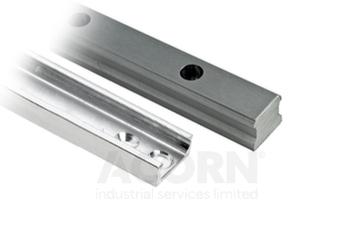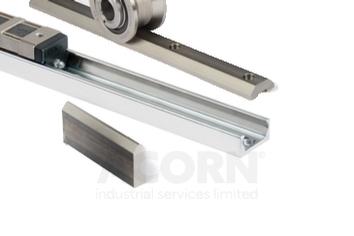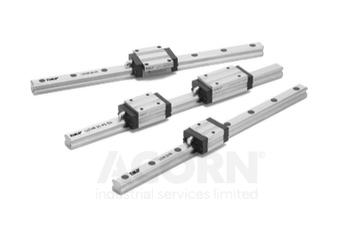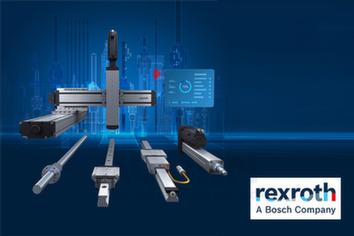- $USD
- SALES TEL: +44 (0)1709 789 933
- Contact us
- Services
- Log in
Linear guide rails are available from leading manufacturers, including THK, EWELLIX and NSK. A new state-of-the-art rail-cutting machine cuts your rail to the required size - Butt-jointing and end-face grinding are also offered. We carefully pack your rail using high-quality packaging and trusted carriers to ensure its safe arrival.
Our LINEAR 24 service aims to dispatch all stocked rail and slide orders within 24 hours of receipt.






Profile rail linear guides utilise recirculating ball bearings (or rollers) within a raceway formed on one side from the rail profile and the other within the carriage.
Linear guides offer high load capacities combined with smooth and accurate movement.
Linear guides are the bed rock of many automated processes and machines. They are available from size 15 all the way up to size 150.
Profile rail linear guides were developed by THK in the 1970s and THK remains the world’s leading manufacturer of linear guides, ball screws and ball splines.
THK HSR, SR, SHS, SSR, HRW, SHW and GSR types are all available from stock, up to size 35. We also stock a vast range of different carriages, including pre-loaded variants.
EWELLIX offers the LLT range of linear guides and we also hold these rails and carriages in stock.
At Acorn, we provide a range of Linear Guides that offer a solution for the vast majority of Linear Guide applications - so if you're looking for linear guides from leading manufacturers such as THK, you've come to the right place. Take a look to find out just what we've got to offer.
Linear guide rails are essential components in numerous industrial applications, providing the precision and stability required for smooth and accurate linear motion. Some of the key applications include:
Manufacturing: The linearity and accuracy provided by linear guide rails, in CNC machines, milling machines, and lathes, ensures that the cutting tool movement is perfect and constant to result in better quality and accuracy in the finished parts.
Automation: Linear guide rails in the automated production line and robotic systems ensure precise positioning and movement of robotic arms and other automation equipment to increase efficiency and productivity.
Medical equipment: In medical devices, linear guide rails feature prominently in devices such as imaging equipment and surgical robots, where precision and reliability have a lot to do with the safety of patients and the effective operation of medical procedures.
Packing: Linear guide rails in the packaging industry are designed to ensure that there will be smooth running and easy movement of the packaging machinery, hence precise and continuous operation from filling to sealing and labelling.
Transportation: The linear guide rails function in varied systems of transport, railway, automotive manufacturing to provide stable and accurate movement to an assembly line and testing equipment.
A linear guide rail works by providing a smooth and precise path for linear motion, allowing a moving component to travel along a fixed axis with minimal friction. The basic components of a linear guide rail system include the rail itself, which is a long, rigid piece of metal with a precisely machined surface, and the carriage or slider, which moves along the rail.
These rolling elements, normally ball bearings or rollers, of the rolling carriage houses minimise friction and thus provide for smooth movement. While one moves the carriage along the rail, these rolling elements rotate, hence spreading the load, which lessens the wear. Such design guarantees a high precision and repeatability, hence making linear guide rails very suitable for applications that require accurate and continuous motion.
Guide rails generally incorporate seals and lubrication systems to prevent contamination and minimise the maintenance burden in order to provide long-lasting performance for demanding applications.
There are a number of essential advantages of linear guide rails, bettering the performance and reliability of machinery and equipment used in industry:
1. High Precision and Accuracy: Through a set of linear guide rails, it's possible to realise high accuracy and repeatability of linear movement. This makes it ideal for applications where precise positioning is required. The reduced friction through rolling elements provides smooth and constant travel along the rail.
2. Rise in Load-carrying Capacity: These linear guide rails are designed to take up heavy loads and perfectly distribute the weight to provide stability and durability under high mechanical stresses. They can operate not only under static but also dynamic loads, hence gaining an application in many industries.
3. Less Friction and Wear: The rolling elements reduce friction between moving parts of the system, hence developing smoother motion and less wear over time. This leads to a longer component life with reduced maintenance costs, reducing overall operating costs and improving efficiency.
4. Improved Rigidity and Stability: Linear guide rails offer excellent rigidity and stability against deflection and deformation under load, thus ensuring consistent performance with reduced mechanical failures for maintaining the accuracy and reliability of high-precision equipment.
5. Easy Installation and Integration: Linear guide rails are designed to be installed and integrated easily into existing systems. Their modularity enables them not only to be customised easily but also to be adopted easily, therefore minimizing your downtime during setup and enabling quick and effective upgrades or replacement.
By incorporating these key benefits, linear guide rails increase the efficiency, reliability, and productivity of your machinery; hence, they become a very valuable investment for any industrial application.
At ACORN industrial services, we can offer linear guide rail to suit your automation project, as well as spare or replacement units. We are committed to providing other linear motion products to meet your industrial needs, from components through to full automated systems:
Linear actuators and automated systems



Linear guide rails are used in various applications to ensure precise linear motion, including automation, CNC machinery, and robotics.
Consider factors such as load capacity, precision, environmental conditions, and compatibility with existing systems. Our specialists can help you make the best choice.
Yes, we offer a rail-cutting service to provide linear guide rails tailored to your specific requirements.
Linear guide rail is a smooth, precise linear motion in a constrained path; for high loads, suitable for CNC machines and robotics. It has a stationary rail with a moving carriage and rolling elements.
While ball screw is a drive converting rotational motion into linear motion with high accuracy and used in applications like CNC machinery and linear actuators. It contains a threaded shaft with a nut containing circulating ball bearings.